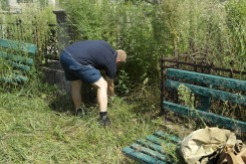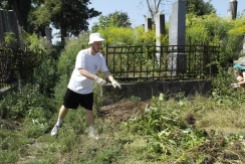Since six years volunteers from all over the world work in the Jewish cemetery of Chernivtsi (Czernowitz). What do they experience and what is the progress in cleaning the cemetery from rampant vegetation?
It’s a Friday morning, when the volunteers come to the cemetery for the first time. The sky is cloudless and bright blue. Even now it is hot – to work in this heat will not be easy. Amanda, the young Dutch wears a floppy hat, she has pulled it down over her face to protect herself from the sun. Somewhat perplexed the young people look around. Before them are eleven hectares of scrub and weeds – emerging from them grave stones. Where to begin here? Whether someone was working here before, Miklós from Hungary wants to know. “Yes,” says Julia, founder and president of SVIT Ukraine. Almost all areas have previously been cleaned – not only by SVIT, also by volunteers of Action Reconciliation Service for Peace and workers hired by the Czernowitz Jewish Cemetery Restoration Organization. “A veritable forest has been here before,” Julia continues. “Now the state is indeed still bad, but hardly comparable with what we found here in 2008 when we started to clean the cemetery,” she says. Julia creates a plan how to start and in which direction the volunteers should continue to work.
The young people try the tools and soon realize what scissors, sickles, machetes and knives are best for. First piles of wood and weeds grow quickly. Small teams are formed, which work very well together. “Martin from Bulgaria and Taka from Japan are a real dream team,” will work-camp leader Jasmin say a few days later while smiling. Aleksandr, who came from the East of Ukraine is a particularly strong young man. You can feel how much physical work is fun for him. Amanda is better in filigree work, she carefully cuts the weeds around a broken tomb. Katja and Jasmin set off for the market to buy fruits and vegetables for the lunch break. The work-camp has begun.
“They make progress with surprising speed,” wonders Sylvia de Swaan. Sylvia is a professional photographer and lives in America. In 1941, she was born in Czernowitz. For a few weeks she is in Czernowitz to take pictures. She accompanies the volunteers with the camera, wants to know more about them. She choosed a light-filled spot in the former mortuary hall and portrays each volunteer. Sylvia talks with them, holding her camera. She does not want a Kodak smile, instead of this she preferres a story. Of Jews he has first heard as a child by his grandmother, says Taka. She told him about the nuclear bombs dropped on Hiroshima and Nagasaki and about the genocide on the Jews, but never compared it. For Taka it was a bridge to an unknown nation, and an unknown history. “Perhaps my grandfather was a Jew,” tells Olena from Ukraine. “The rumor existed in the family, but now I can not ask my grandfather, he is long dead,” she adds. Every volunteer has his own story and his own motive to participate in the work-camp in the Jewish cemetery of Czernowitz.
On weekends, the volunteers do not work. They have time to relax or to enjoy the city and its surroundings. On a Sundays they are out for an excursion. By bus they explore the former shtetl in Bukovina and neighboring Galicia. Vashkivtsi (Waschkautz), Kosiv (Kossow), Vyzhnytsia (Wischnitz) and Storozhynets are on the schedule – a very different world compared to urban Czernowitz. Four places, four Jewish cemeteries, four stories of Jewish life and its destruction. It’s not easy to cope with for the young people. The cemetery in Storozhynets is the most similar to the one in Czernowitz, grave stones in European style, no Hasidic community, which would have left their traces here. At the end of the cemetery is a monument on a mass grave. 250 people were shot here. On the way is a grave stone for a Dr. Drucker. The inscription proclaims that he was cruelly murdered by Ukrainian Nationalists. This was in 1945. The war was already over, the killing was not. None of these visits are easy for the young people – at least not for the German and Ukrainian participants.
“How many people here know about local history?” Miklós, the young Hungarian wants to know. In the Jewish cemetery of Storozhynets the volunteers meet a family that cleans the grave of a relative. The grave stone is obviously from the Soviet era. Jasmin, who speaks Russian well, and some others go to talk with those locals. “Many of the grave stones have inscriptions in English”, the locals tell. If she could see them, asks Jasmin. “This is not English, this is German,” she shakes her head. “German was spoken here?” the locals wonder. One of the many possible answers to Miklós’ question.
Work-camps in the Jewish cemetery of Czernowitz are important lessons against forgetting. Young people from Europe and around the world are learning about the Jewish and multicultural heritage that makes up our common identity. This is a value in itself. Nevertheless, the question must be allowed whether the work-camps contribute to the preservation of the Jewish cemetery in Czernowitz in a sense of sustainability. At least the volunteers who sacrifice their time, ask this question.
The work-camps of SVIT Ukraine and Action Reconciliation Service for Peace have a media response. Local press and regional television report. There is an official reception in the City Hall – this is worth media reports as well. This has effects. Today, everyone in town knows that there is a significant Jewish cemetery. It was different a few years ago. With a map in hand, you could ask a passerby for the direction to the cemetery and earn a shake of the head. Perhaps this is the most important change. In the end, what matters is whether local people accept and appreciate the Jewish cemetery as worth of preservation and part of their own heritage. This road is long and winding. But it’s worth to try. “One has to imagine Sisyphus as a happy man,” the French philosopher Albert Camus once wrote. He’s right.
Everyone can contribute to the preservation of the Jewish cemetery of Czernowitz – by working as a volunteer, or by donating. Both volunteer services are not confined to any particular age. In the work-camps of SVIT Ukraine mainly young people take part, the summer camps of Action Reconciliation are specifically designed for the age group of 45+.
More information about workcamps in Czernowitz:
SVIT Ukraine: http://svit-ukraine.blogspot.de/
Action Reconciliation Service for Peace: http://www.asf-ev.de/

This work is licensed under a Creative Commons Attribution-NonCommercial-NoDerivs 3.0 Unported License.












A pleasure to read. From the perspective of one of the volunteers in the original 2008 group, and whose great grandparents are buried in the cememtery, it is so gratifying to know not only that the work continues, but also that now everyone in the city knows about the cemetery.
Joanna Liss
Pingback: Report from volunteers cleaning Jewish cemetery in Chernivtsi | Jewish Heritage Europe